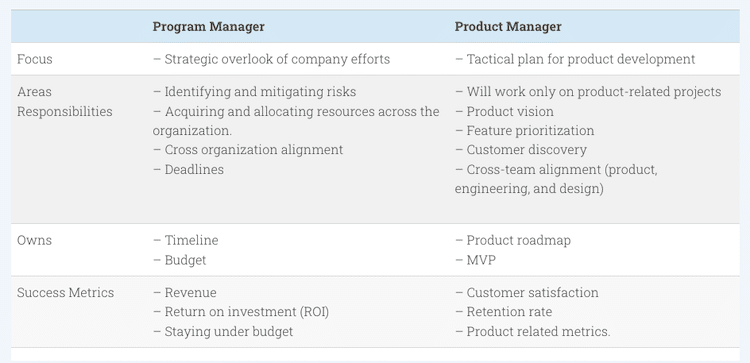Are you a product manager working their way up the corporate ladder? Ever feel like you are at the mercy of senior company executives? Learn how to leverage your product management skills to connect the product roadmap and corporate strategy in such away that benefits both your career and organization. While any semi experienced product manager knows that the best roadmaps:
- Provide the sense of the ownership needed for each project,
- Determine the order in which the projects should happen.
We are going to teach you how to layer in some organizational and political skills to your product roadmap process to make sure all your hard work doesn’t go to wast
As alluded to earlier in describing the product roadmap process, the first step in product roadmap creation is much more political than mechanical in action; setting the vision and strategic goals for the product — and, more importantly, getting alignment on these with your stakeholders — is the first step to creating a successful roadmap.

The second step is realizing that most corporate executives people don’t care how the sausage is made, they just want to know:
- Where the product is going,
- Why is it going there
- Does the product strategy align with the corporate vision.
How you get this done it as product manager, is your business.
An astute product manager leverages the combination of company politics, the average corporate executive’s proclivity for big picture thinking and key performance indicators to their advantage to connect (as well as influence) the product roadmap and corporate strategy
Typical Product Roadmap Corporate Strategy Challenges
Let the Blinding Flashes of The Obvious Shine On Through.....
If you deal with a lot of business school types, you’ll hear buzzwords like “Top Down Strategic Planning“, which means if you work with managers who have a lot of “vision” but not a lot of “hands on, domain expertise”, you spend a lot of time dealing with what can best be described as “blinding flashes of the obvious” that are often passed off as “strategic brilliance“, backed up by opinion, but not data.

This contributes to the difficulty in building/maintaining product roadmaps. Ask any product managers who is 5 to 10 years into their career and you hear a constant theme of frustration associated with product roadmap challenges that executives/stakeholders aren’t on board with the product strategy, due to two main reason:
- Executive simply do not have the domain expertise to know how to prioritize properly, yet get their way through intimidation, either real or perceived. To their own long term detriment, they are often focused on superficial items like color schemes and layouts rather than the details of a properly prioritized roadmap. This often ends up in a situation where the roadmap prioritizes everything and nothing gets achieved. Most product managers end up submitting to the will of the senior executive, well, because, I guess they like the pay check and these situations are not hills worth dying on.
- The inconsistent and inappropriate application of terms like vision, strategy, and tactics to the product roadmap distracts from what it is that the product roadmap needs to accomplish.
Strategic decisions are essential for your product’s eventual success in the market. But product managers today face several challenges — some organizational — in developing roadmaps that are not as effective as they could be.
While it’s easy for someone like me, sitting behind a keyboard, to be dismissive of the entire top down approach to planning, the reality is that you need to know how to make the process work for you, so I’m gonna tell you the secret to managing management with the product roadmap, or at least amuse you with my sardonic take on product management.
The Politics of Product Roadmaps: Managing Management
As a product manager, accept two things about executives as part of your reality:
- A large number of them like “top-down strategic planning” and communication; executive teams don’t really care much about the details. They want a product roadmap that:
- Fits with the strategic direction of the company
- Tells them when will product be delivered.
- It is better for your career to be seen as a valuable resource respected by upper management than as a shit disturber. If you can entertain your senior management team with your witty repartee, awesome, but remember to never outshine the master.
How you relate to your managers is going to be key to career success, especially at the beginning of you career.
Know this, there is a substantial amount of ego to deal with when having discussions with executives about future product vision, goals and strategy; depending on the professional experience of any given manager, the vision and goals may or may not be well informed, but you still need to work within the confines of this top-down discussion, regardless of your personal opinions of their expertise.
The blunt truth is that due to the nature of relationship capital within an organization, top down planning has a greater chance of producing a product roadmap that moves the needle for the company (Sorry to burst your bubbles, but your senior manager with P&L responsibilities within the organization probably has more organizational pull than your sorry ass, no matter how brilliant your ideas are. They have he ability to get things done where you can’t), so you just need to know how to leverage the product roadmap process work for you and your probable preference for bottom up planning.

The boiler plate advice for dealing with these situations is usually something along the lines of “Share high-level product vision to get the executive team on board with the strategy“. Sure, this great advice if you want to ignore things like corporate politics, department budgets, conflicts of interest and competing priorities as well as the reality that executives don’t know or care much about product details. Also, shouldn’t someone define “high level product vision“?
The right approach to making the top down strategic planning work for you is to “make management look good” (repeat that three times to yourself the next time you get mad at a manager) ; this approach has two basic tenets, violate either of these and you might find yourself involved in a resume creating event:
- If there is part of a product roadmap being touted by an executive that you disagree with, talk to the points with data. In fact, back up all your decisions with data, ideally empirical data, but you can also use analytical when needed.
- Be tactful when presenting your disagreements to managers, especially in group environments. Unless you know a manager to be thoughtful, considerate and non ego driven, assume they are not. You never know how much political or social capital a manager has invested in the product you are collaborating with them on, so you can be rest assured that if you stand up in a large group meeting and start spouting off data that doesn’t support the current product vision/roadmap, you will cause someone great embarrassment. People do not like to be embarrassed.
People do not like to be embarrassed.
In corporate speak, the approach outlined above is called being collaborative.
The Executive Product Roadmap
As alluded to earlier, the product roadmap is actually a group of documents. One of those documents is geared to executive level stakeholders and is meant to be kept “high level“, meaning it describes the product strategy to achieve the business goals dictated by the executive team’s vision, while defining success with metric driven KPIs.
To have a product roadmap mean that you should probably have a product strategy, because if you don’t, there isn’t much to put on the roadmap. Product strategy (which is really gets laid out on the product roadmap for executives) is the path that organizations choose to take in order to achieve its goals.
In other words, product strategy describe “how” the organization, or product team, intends to achieve a desired future state, providing a high-level context for a set of activities or milestones that are to be pursued and strives to be directionally correct and should address the following. It’s a high-level plan to achieve your vision or overarching goal and should describe:
- What product will it become?
- Who will it benefit?
- How will it create value?
- Who the product is for
- Why people would want to buy and to use it;
- What the product is and why it stands out; and
- What the business goals are
- How do we define success in KPIs
As alluded to previously, the product roadmap is not a document you start drafting without understanding where where you are taking a product. Much like planning a road trip, you need to have a destination in mind before plotting a course with the roadmap );
The executive product roadmap is the operationalization of the strategy, articulating what needs to be accomplished, why it needs to be accomplished, and for whom. When developing a strategy that ultimately leads to a product roadmap, it’s important to identify and articulate your product’s vision and principles — the “why.”
You must be able to articulate and defend the strategy as well as the operationalization of the strategy with data in order to get buy-in from various stakeholders who will have competing interests to yours.
Crafting the product strategy means determining the product’s mission, and distilling it into a simple statement your stakeholders can understand. This includes product vision, the problems it solves, its target customers, and its value to the marketplace. Documenting this forces you to nail down many of the key items that will inform other portions of the product development process, such as informing:
- Your executives of your plans for your product’s development and updates — because they will ultimately need to sign off on those plans.
- Your development teams need to know what you have planned for your product, and why, because they will be responsible for building it.
- Your sales, service, and marketing so they can articulate your strategy to the market.
In addition to saving your product from becoming a solution in search of a problem, this strategy-first approach has several benefits:
- It makes it easier to articulate the product vision to any constituency across your company, and ensure your stakeholders are on the same page before you begin the detailed conversations that follow.
- It makes it easier for you to clearly see your product’s vision, and allows you throughout the roadmap process to more clearly identify priorities as well as those items that should be set aside because they don’t serve the product vision.
Defining Your Product Goals
Make sure you use metrics.....
Coming up with product goals is the step that helps you translate your product strategy into an executable plan, that gets visualized by the roadmap.
An important part of defining goals is defining the success metrics ( See our article on Product Management and User Metrics for a deeper dive on the topic) . While every organization’s product goals are different and you can develop product-specific, company-oriented, or more generic goals, business goals can be grouped into the following groups
- Competitive Differentiation
- Customer Delight
- Technical Improvements
- Product Features
- Improve Customer Satisfaction
- Increase Lifetime Value
- Upsell New Services
- Reduce Churn
- Expand Geographically
- Mobile Adoption
The important thing with any of these goals is tying them to Key Performance Indicators (KPIs) that align with stakeholder interests. From an ongoing operational point of view, it is KPIs that tie the product roadmap to corporate strategy.
From an ongoing operational point of view, it is KPIs that tie the product roadmap to corporate strategy.
The Product Roadmap And Corporate Strategy Planning
The product roadmap, which is tied to the organization’s vision and strategic goals for the next 12 or more months, defines a strategic view of where the product is headed over the mid to long term, providing guidance rather than a strict project plan. The roadmap needs to communicate the big picture to the organization — the initiatives that move the needle, expand markets, address competition, and create customer value.
The longer-term portion of the roadmap outlines product capabilities that reside outside the organization’s current planning activities and are effectively queued while the current priorities are being developed. This section provides a directional view of where the product might head given current business conditions in the next 12 months or longer. Any major changes in the current projects, the external marketplace, or internally in the business can change these envisioned future releases. For products or platforms with relatively long lives or industries that are relatively slow-moving, the long-term view can project out multiple years or span a predetermined lifecycle
The Backlog is Not a Roadmap

Your executive product roadmap cannot simply be a list of features; it must convey high-level strategy, goals and vision. It’s challenging to communicate strategy in a list that’s 200 items long, especially to executives and other stakeholders who might not think in terms of iterations or sprints. A roadmap speaks in terms of epics and themes, while the backlog represents the detailed features and other tasks that deliver the product. In a sense, the backlog is a translation of how your team will deliver the vision outlined in the product roadmap.
sharing product roadmaps with the engineers to give perspective to the backlog. This helps the development organization understand how the next few sprints fit into the big picture.
A fundamental principle of roadmaps is they change, so set expectations with your stakeholders that the roadmap is not a promise. A political tactic used by experience product managers is o leave the dates off altogether to avoid setting the impression that features will be delivered by a specific date.
Let’s look at a few of these typical challenges to creating effective product roadmaps, and how to overcome them. These challenges and solutions go beyond the roadmap document and get to the heart of the process you use to develop the roadmap.
Product Roadmap Planning Challenges
Locking In Long Term Plans
Many product managers today build roadmaps with long-term plans and deliverables locked in, sometimes years into the future. But market demands and opportunities, as well as new technologies, often require mid-stream changes in a product’s development or priorities.
This is why successful executive product roadmaps are positioned as living documents, focused on high-level product strategy and organization goals. Astute product managers need to build in operational flexibility to adjust plans and priorities quickly and easily.
Your roadmap must effectively communicate milestone flexibility to all constituencies in order to meet the high-level goals for the product rather than a specific dogmatic deadline.
Prioritizing In The Moment (aka How To Avoid Holding The Bag)
It is the product manager’s responsibility — at an early stage, when developing the roadmap — to create goals that drive prioritization. The product manager must also prioritize the product’s development within the larger context of parallel initiatives within the organization.
The mark of an experienced product manager is the inclusion of a prioritization framework into the product decision making process as it gives you leverage when faced with deciding whether to prioritize a stakeholder’s pet project or a feature required by a big prospect. It forces senior management to rationalize and defend their decisions while relieving you of some/all of the political responsibility, which is especially important things go all pear shaped.

Using Metrics to Support Your Roadmap
Data is much like money, food and water, have too much and it can cause you problems, while not having enough causes people a different set of problem. While obviously useful, as metric-driven product management is now at the foundation of most successful products, incoporating data into product roadmaps is problematic in two ways:
- Too Much Data. We are literally drowning in data and if people don’t understand the relevancy of data, they either throw numbers around indiscriminately or worse yet, don’t understand the significants of metrics and how they relate back to KPIs, which according to Oxford Dictionary, are “a quantifiable measure used to evaluate the success of an organization, employee, etc. in meeting objectives for performance”.
- Lack of Data: But new products or features that are on your roadmap are sometimes challenging because there is rarely a history of data.
As metrics/data are the basis of KPIs, knowing which KPIs to select in order to connect the product roadmap with corporate strategy is critical. In order to select the right KPI to monitor the performance of a product, consider the following challenges you need to address:
Defining the Metrics Early
Performance metrics are political and as a product manager, you are more likely to have a better understanding than corporate executives about relevant metrics and KPIs, so beyond the fact that the onus is on you to set the table for your success, take advantage of your domain expertise and define the right metrics early. In addition to getting better insight to guide your product decisions and your product roadmap, you assume a position of control as most executives are going to be too busy to get into a down in the weeds argument about the merits of various KPIs, but remember, focus on a few metrics to avoid drowning
Understanding Different Types of Data
When diving into data, you need to know there are multiple types that could use:
- Operational Data is data produced by an organization’s day to day operations, think website sessions, users, clicks, sales.
- Analytical data is when an organization’s operational data is used in the business decisions making process. This include grouping customers for market segmentation or changes in purchase volume over time.
- Empirical data is information acquired by observation or experimentation and is part of the scientific method which involves developing a hypothesis, define a test, and measuring the outcome
You might decide that a conversion metric is important to measure — such as the percentage of trial customers who convert to paying customers. Even without solid customer data, you can create a hypothesis about what you think you will see and a target of what is ideal. This process itself is incredibly valuable because you’ll have great conversations with the team about the business model and will be able to spot challenges early on once the customer data begins arriving.
Selecting The Right KPI
Ultimately, the metrics you choose depend on the stage of your product, your industry, the type of product, and the size of your company.
But the most important consideration is to focus on a limited number of metrics that really matter. These are metrics that tie back to the organization’s top-line goals and business results.
Avoid “vanity metrics,” those metrics that feel good but don’t connect to corporate goals.
Look at information about competitive products — companies that are publicly traded will often discuss those metrics during earnings calls.
Generally speaking, business goals such as revenue, margin, acquisition cost and retention are good places to start. Customer-specific metrics such as product usage and retention are good starting points as well.
You’ll pick a handful of these metrics to set the baseline — these are a great place to start, but ultimately you’ll refine the metrics for your business. Work with your team to get consensus on the metrics that matter.
These are actionable metrics that tie back to the strategic goals and initiatives you put on your product roadmap. Revise the goals and metrics periodically — as the product matures, the metrics will need to change and likely grow with it.
Conclusion
Understanding that the product roadmap serves as both an operational and political tool within companies is critical to your ability to execute on one. If there is one thing you take away from this article, learn how to properly employ KPIs in order to tie the product roadmap to corporate strategy.





